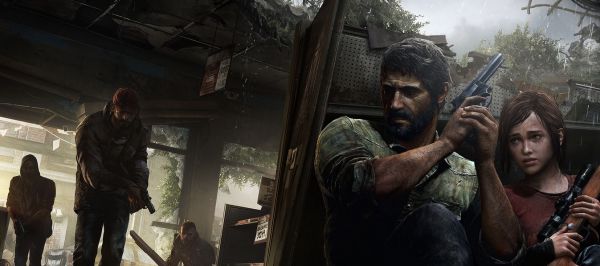Beyond Co-Op Reviews: The Last of Us

I had no interest in The Last of Us until the reviews came in and blew up Metacritic a week before E3. I’ve attempted to play through Uncharted and Uncharted 2, buy Naughty Dog’s combat system makes me want to punch things. Having a tagalong AI character is the stuff of my digital nightmares. I know it worked in Bioshock Infinite, but could there really be two successful, quality games based entirely on the loathsome escort mission in one year?
Yup.
The Last of Us is an interesting experience. From the sucker punch opening to the elegant conclusion, it’s a fascinating character study of human relationships anchored by some of our most primal wants and needs. So what does that BS mean? It means actively participating in a burgeoning paternal relationship during a fungal zombie apocalypse backdropped by the collapse of American society is a hell of a thing. Once humanity is back on the food chain everything changes. Or does it?

The story of Joel and Ellie’s cross country odyssey is beautifully presented visually, musically, and dramatically. The game is a graphical standout on the PlayStation 3. The subtle soundtrack sets a tone of overwhelming sorrow. Troy Baker and Ashely Johnson’s performances may be the best I’ve ever experienced in a video game.
I do wish The Last of Us was stronger when it came to the actual gameplay.
Combat mixes stealth and open firefights with varying degrees of success. Overall it’s alright. It’s not necessarily bad, but at times it falters. There are two basic threats: humans and cordyceps zombies. Most encounters begin with Joel and Ellie approaching a group of enemies who have no idea they’re about to be ambushed. Then it’s up to you to decide if you want to go in shooting or stealthily dispatch your foes. Death is gruesome and violent, both for the player and the enemies. But the overly long encounters will quickly desensitize you to the violence.
Immersion is often trampled under the heavy feet of the companion AI. They routinely break cover, blunder into enemies, and just plain get in the way. Enemies don’t react to your companions unless the player’s stealth is broken, so it’s not uncommon for friendlies to be “hiding” right in front of a human hunter. It’s hard to worry about an NPC’s safety when she’s quietly squatting on the wrong side of cover with her face in a zombie’s crotch. Many of my encounters were prematurely forced from covert killing to a stand up gunfight when Ellie would come between me and a hunter’s neck, giving him a split second to react and shout a warning. In a game where ammo is at a premium this is beyond frustrating. Friendly AI will fight effectively at times, but I felt they did just as much harm as good.
While the The Last of Us does give players the option to openly fight, quietly dispatch foes, or simply work your way around them, I did feel shoehorned into most scenarios. A few times I silently worked my way to the other side of an encounter only to be confronted by an enemy who would always raise an alarm, forcing me to fight from a surrounded position. Other times I would forsake stealth and begin a firefight only to be completely swarmed by enemies. In later stages this isn’t much of a problem, because Joel gets pretty damn badass, but it’s punishing in the early and middle levels.

There might not be a definitive “right” or “wrong” way to approach a mob, but I felt compelled to enter each situation in the exact same manner: I would stealth kill as many people as possible. The AI would eventually give my position away. Hopefully I had gathered enough ammo and supplies to repel the first wave of enemies. I'd be forced into a quick, chaotic gunfight. I'd then retreat to reinitiate stealth and quickly craft bombs, molotov cocktails, and health kits while reloading my weapons. Repeat. That’s how I dealt with most of the encounters. At first it was exciting, if at times nerve-wracking. Then it became tedious.
When you aren’t snapping necks or stabbing faces you will spend most of the time scouring the beautifully dilapidated environments for ammo, crafting ingredients, stat-enhancing supplements, or upgrade-granting training manuals. The 20 year withering of the human race has taken a toll the man-made infrastructure. Or you could say our decline has allowed the world to heal itself, depending upon how you look at it. There’s a pleasant amount of verdant growth in this post- apocalyptic world. While rummaging for supplies there will be an occasional cue for conversation. These tender moments help to make the game a cohesive experience. Without them The Last of Us would simply be an above average third person survival horror game with brilliant cut scenes.
"Factions," the multiplayer mode, will let you test your survival skills against other players. I’m horrible at MP, which is why I stick to co-op games. Factions focuses on stealth, positioning, ammo conservation, and gathering supplies. It’s an interesting concept and it’s different enough where I think it will garner a small, but dedicated fan base. The single player campaign could stand on its own, but it’s a nice addition.
As good as The Last of Us is, it doesn’t offer a very unique or original tale. We’ve been down several forks of this road before. This just happens to be one of the best forks of that particular road. The gameplay is good, not great. As a whole it’s incredibly well done, and well worth the journey. Anyone who enjoys character development and dramatic presentation in any form of media should experience this game.
4.5